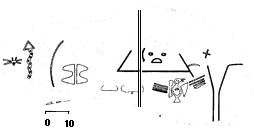 |
Science Frontiers ONLINE No. 63: May-Jun 1989 |
|
|
Peruvian Geoglyphs
By now, just about everyone has seen the very impressive aerial photographs of the famous Nazca lines in Peru. It is not as well known that many other "geoglyphs" are to be found elsewhere in South America.
 Plan view of some Santa Valley geoglyphs from Peru. The scale at the lower left represents 10 meters. The vertical double line is not a geoglyph but rather the azimuth heading 280-degrees. It is hard to imagine how such underground drawings could be used for rituals. |
"For example, several areas that contain crosscrossing lines and figures similar to those of Nazca have recently been studied on the central coast [of Peru] between the FortalezaPativilca and Rimac valleys. Additional lines have been reported for Viru Valley, on the north coast, and for the Zana Valley, over 1,000 km to the north of Nazca. Interestingly, most coastal ground drawings that can be dated tentatively, either by associated ceramic remains and sites or by their similarity to diagnostic pottery motifs, fall in the earlier part of the Early Intermediate period (ca. 350 B.C. to A.D. 650) - i.e., to a time following the establishment of irrigation agriculture as the primary subsistence focus, but prior to the rise of state societies.
"As is well known, several studies have been conducted that involved mapping and computer analysis of the Nazca lines to examine the hypothesis that they were related to astronomical phenomena. This theory is now discounted, at least as it applies to the great majority of the lines which do not appear to have been oriented toward the sky. More recent studies dealing with the lines have provided convincing arguments. primarily through comparison with lines currently in use on the Bolivian altiplano, that they were constructed as part of elaborate ritual ceremonies related to agricultural fertility."
(Wilson, David J.; "Desert Ground Drawings in the Lower Santa Valley, North Coast of Peru," American Antiquity," 53:794, 1988.)
Comment. Not surprisingly, the author of the above article, D.J. Wilson, has neglected the popular theory that the Nazca lines were etched to attract and guide extraterrestrial visitors. Mainstream archeology always opts for ex planations involving rituals and societyunifying activities. But why make geoglyphs that cover hundreds of square miles and can hardly be appreciated at all from the ground?
Getting back to the article itself, Wilson continues in some detail with the Santa Valley geoglyphs. These differ from the classical Nazca lines in that they display fewer abstract designs and more representations of llamas, condors, and other animals. They are, however, of impressive size and well-executed.
Reference. Our handbook Ancient Man offers a photo and considerable more detail on the Nazca lines and other geoglyphs. For details, visit: here.